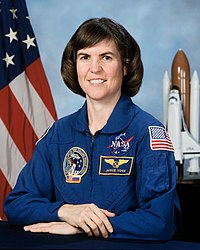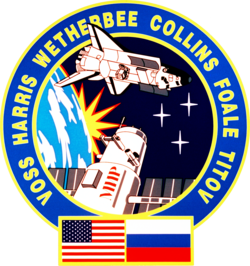Janice Elaine Voss
| Janice Voss | |
|---|---|
 | |
| Land | USA |
| Organisation | NASA |
| ausgewählt | 17. Januar 1990 (13. NASA-Gruppe) |
| Einsätze | 5 Raumflüge |
| Start des ersten Raumflugs | 21. Juni 1993 |
| Landung des letzten Raumflugs | 22. Februar 2000 |
| Zeit im Weltraum | 49d 3h 49min |
| ausgeschieden | Februar 2012 (verstorben) |
| Raumflüge | |
Janice Elaine Voss (* 8. Oktober 1956 in South Bend, Indiana; † 6. Februar 2012 in Scottsdale, Arizona) war eine US-amerikanische Astronautin.
Leben
Voss lebte von 1960 bis 1967 in Rockford, Illinois, wo sie die Guilford Center School besuchte. Ihren Schulabschluss machte sie 1972 in Wilbraham, Massachusetts. 1975 erhielt sie einen Bachelor in Ingenieurwesen von der Purdue University und 1977 einen Master in Elektrotechnik vom Massachusetts Institute of Technology (MIT). 1987 erhielt sie eine Promotion in Luft- und Raumfahrttechnik, ebenfalls vom MIT.
Voss war von 1973 bis 1975 Mitarbeiterin der NASA am Lyndon B. Johnson Space Center. Während dieser Zeit führte sie Computersimulationen in der Ingenieurs- und Entwicklungsabteilung durch. Nach ihrem Studium am MIT kehrte sie 1977 ins Johnson Space Center zurück und arbeitete für ein Jahr als Mannschaftstrainerin, speziell für den Wiedereintritt.
Voss arbeitete ab 1987 bei der Firma Orbital Sciences Corporation. Sie war dort für die TOS-Oberstufe (Transfer Orbit Stage) zuständig. Mit dieser Oberstufe wurde im September 1993 der Advanced Communications Technology Satellite (ACTS) von einem Space Shuttle und im Herbst 1992 die Raumsonde Mars Observer von einer Titan-Rakete gestartet.
Im Januar 1990 wurde Voss von der NASA als Astronautenanwärterin ausgewählt. Von Oktober 2004 bis November 2007 war sie wissenschaftlicher Direktor für das Kepler-Weltraumteleskop am Ames Research Center der NASA. Zuletzt arbeitete sie als Leiterin für Nutzlasten in der Raumstationsabteilung des Astronautenbüros. Sie starb im Alter von 55 Jahren an Brustkrebs.
Der am 13. Juli 2014 gestartete Cygnus Orb-2 Raumtransporter wurde nach ihr benannt.
STS-57
Am 21. Juni 1993 startete Voss mit der Raumfähre Endeavour zu ihrem ersten Flug ins All. Das Hauptziel dieser Mission war die Bergung des European Retrievable Carrier Satellite (EURECA). Zusätzlich war erstmals das Spacehab zur Durchführung verschiedener Experimente mit an Bord.
STS-63
Am 3. Februar 1995 startete Voss als Missionsspezialistin mit der Raumfähre Discovery zum ersten Flug eines Shuttles zur Raumstation Mir. Während der Mission näherte sich der Orbiter am vierten Flugtag der Mir bis auf elf Meter und hielt diese Position für zehn Minuten. Im weiteren Verlauf der Mission wurde die Plattform SPARTAN 204 ausgesetzt und wieder eingefangen sowie ein viereinhalbstündiger Weltraumausstieg durchgeführt. Erstmals wurde das Space Shuttle mit der Pilotin Eileen Collins von einer Frau gesteuert.
STS-83
Am 4. April 1997 startete Voss mit der Raumfähre Columbia ins All. Nutzlast war das Microgravity Science Laboratory (MSL-1). Aufgrund eines Problems mit einer Brennstoffzelle des Shuttles musste die Mission abgekürzt werden und die Landung erfolgte bereits nach knapp vier Tagen. Die NASA entschied, die Mission drei Monate später mit der gleichen Besatzung zu wiederholen.
STS-94
Am 1. Juli 1997 startete die Columbia dann erneut zu der beim ersten Versuch vorzeitig abgebrochenen MSL-1-Mission. Diesmal konnten die Experimente im Microgravity Science Laboratory erfolgreich durchgeführt werden. Dazu zählten vor allem Experimente zur Erforschung der physikalischen Eigenschaften unterkühlter Flüssigkeitsgemische und der Verbrennungsprozesse an festen und flüssigen Materialien sowie zur Herstellung reiner Proteinkristalle.
STS-99
Am 11. Februar 2000 flog Voss mit dem Space Shuttle Endeavour zur sogenannten Shuttle Radar Topography Mission. Dabei kartografierte sie mittels Radar 80 Prozent der Landmasse der Erde. Zwei Radarsysteme, eines in der Nutzlastbucht des Shuttles, das andere an einem 60 Meter langen Mast montiert, tasteten die Erdoberfläche ab. Das Resultat war ein digitales dreidimensionales Modell der Erde von bisher nicht gekannter Genauigkeit. Um ein Arbeiten rund um die Uhr zu ermöglichen, war die sechsköpfige Besatzung in zwei Teams aufgeteilt, die im Zwölf-Stunden-Betrieb arbeiteten. Voss bildete mit Pilot Dominic Gorie und Missionsspezialist Mamoru Mōri das blaue Team.
Literatur
- Dennis Hevesi: Janice Voss, Shuttle Astronaut and Scientist, Dies at 55. In: The New York Times, 9. Februar 2012.
Siehe auch
Weblinks
- Biografie von Janice Elaine Voss in der Encyclopedia Astronautica (englisch)
- Kurzbiografie von Janice Elaine Voss bei spacefacts.de
- NASA-Biografie von Janice Elaine Voss (englisch; PDF)
- Reuters: Todesmeldung
| Personendaten | |
|---|---|
| NAME | Voss, Janice Elaine |
| KURZBESCHREIBUNG | US-amerikanische Astronautin |
| GEBURTSDATUM | 8. Oktober 1956 |
| GEBURTSORT | South Bend (Indiana), Indiana, USA |
| STERBEDATUM | 6. Februar 2012 |
| STERBEORT | Scottsdale, Arizona |
Auf dieser Seite verwendete Medien
Mission Specialist Janice Voss, holding a camera, cable, & batteries, floats through the spacelab tunnel adapter on her way to the SPACEHAB module aboard Endeavour. Barely visible in the background are Endeavour's forward middeck lockers. SPACEHAB tunnel hatch lies open below Voss. Also visible are air circulation duct, tunnel light switches, handrails.
STS099-(S)-001 (JUNE 1999) STS-99 INSIGNIA -- The crew members designed the flight insignia for the Shuttle Radar Topography Mission (SRTM), the most ambitious Earth mapping mission to date. Two radar antennas, one located in the Shuttle bay and the other located on the end of a 60-meter deployable mast, will be used during the mission to map Earth's features. The goal is to provide a 3-dimensional topographic map of the world's surface up to the Arctic and Antarctic Circles. The clear portion of Earth illustrates the radar beams penetrating its cloudy atmosphere and the unique understanding of the home planet that is provided by space travel. The grid on Earth reflects the mapping character of the SRTM mission. The patch depicts the Space Shuttle Endeavour orbiting Earth in a star spangled universe. The rainbow along Earth's horizon resembles an orbital sunrise. The crew deems the bright colors of the rainbow as symbolic of the bright future ahead because of human beings' venturing into space.
STS-57 Endeavour, Orbiter Vehicle (OV) 105, crew insignia (logo), the Official insignia of the NASA STS-57 mission, depicts the Space Shuttle Endeavour maneuvering to retrieve the European Retrievable Carrier (EURECA) microgravity experiment satellite. Spacehab -- the first commercial space laboratory -- is depicted in the cargo bay (payload bay (PLB)), and its characteristic shape is represented by the inner red border of the patch. The three gold plumes surrounded the five stars trailing EURECA are suggestive of the United States (U.S.) astronaut logo. The five gold stars together with the shape of the orbiter's mechanical arm form the mission's numerical designation. The six stars on the American flag represent the U.S. astronauts who comprise the crew. With detailed input from the crewmembers, the final artwork was accomplished by artist Tim Hall. The names of the STS-57 flight crewmembers are located along the border of the patch. They are Commander Ronald J. Grabe, Pilot Brian J.
STS-63 Mission Insignia
High angle shot inside the SPACEHAB module. Janice Voss handles a Commercial Generic Bioprocessing Apparatus group activation pack incubator at the aft lockers in the foreground while Nancy Sherlock handles a small piece of equipment and Pilot Brian Duffy makes notations on a checklist in the background.
The crew patch for NASA's STS-83 mission depicts the Space Shuttle Columbia launching into space for the first Microgravity Sciences Laboratory 1 (MSL-1) mission. MSL-1 investigated materials science, fluid dynamics, biotechnology, and combustion science in the microgravity environment of space, experiments that were conducted in the Spacelab Module in the Space Shuttle Columbia's cargo bay. The center circle symbolizes a free liquid under microgravity conditions representing various fluid and materials science experiments. Symbolic of the combustion experiments is the surrounding starburst of a blue flame burning in space. The 3-lobed shape of the outermost starburst ring traces the dot pattern of a transmission Laue photograph typical of biotechnology experiments. The numerical designation for the mission is shown at bottom center. As a forerunner to missions involving International Space Station (ISS), STS-83 represented the hope that scientific results and knowledge gained during the flight will be applied to solving problems on Earth for the benefit and advancement of humankind.
STS-94 insignia
Astronaut Janice Voss, mission specialist









